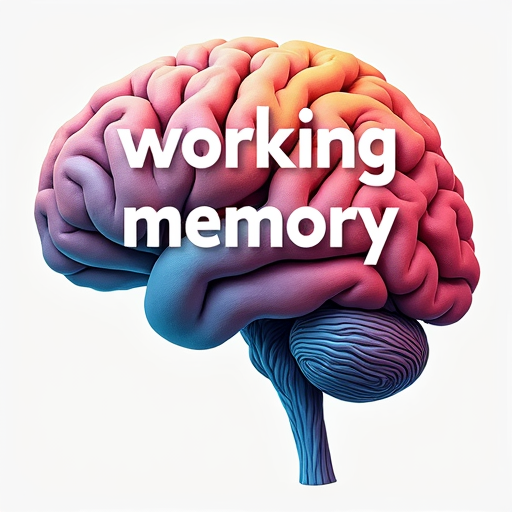Multicomponent Model
The multicomponent model, originally proposed by Baddeley and Hitch (1974), remains one of the most influential frameworks in working memory (WM) research. This model posits that WM is not a unitary storage system but comprises several specialized components: the phonological loop (for verbal and auditory information), the visuospatial sketchpad (for visual and spatial data), and the central executive (for attentional control and coordination). Later, the episodic buffer was added as a fourth component, integrating information from the other subsystems and long-term memory into multidimensional representations (Baddeley, 2000a; Baddeley, 2010; Logie et al., 2021).
Each subsystem has distinct functions. The phonological loop is responsible for the temporary storage and rehearsal of verbal material, while the visuospatial sketchpad manages visual and spatial information. The central executive acts as a supervisory system, allocating attention, switching between tasks, and inhibiting irrelevant information. The episodic buffer, introduced in 2000, serves as a limited-capacity storage system that binds information from different modalities and interfaces with long-term memory (Baddeley, 2000a; Logie et al., 2021). Experimental paradigms such as dual-task interference, neuropsychological case studies, and neuroimaging have validated the separability and interaction of these components (Logie et al., 2021; Baddeley, 2010).
The model has evolved to account for a wide range of cognitive phenomena, from language comprehension to problem-solving, and has been instrumental in understanding cognitive deficits in clinical populations (Baddeley, 2010; Logie et al., 2021).
Embedded-Processes and Attentional Models
The embedded-processes model, developed by Cowan (1999, 2005), offers a contrasting perspective by emphasizing the dynamic interplay between attention and memory. In this model, WM is conceptualized as an activated subset of long-term memory, with a smaller subset within the “focus of attention” that is directly accessible for cognitive processing (Cowan, 2005; Cowan, 2008; Oberauer & Kliegl, 2006).
The model proposes a hierarchical structure:
- Long-term memory contains all stored knowledge.
- A subset of this knowledge becomes temporarily activated (i.e., accessible for ongoing tasks).
- Within this activated set, a further subset is in the focus of attention, typically limited to about four items (Cowan, 2001; Oberauer & Kliegl, 2006).
Maintenance in WM can occur through two mechanisms: rehearsal (particularly for verbal material) and attentional refreshing, where attention is cyclically refocused on items to prevent decay (Cowan, 1999; Lewandowsky & Oberauer, 2008). The central controller manages these processes, allocating domain-general attentional resources (Cowan, 1999).
Empirical support for this model comes from behavioral studies, neuroimaging, and experiments on the effects of irrelevant information, which show that the focus of attention is a key determinant of WM capacity and performance (Cowan, 2001; Lewandowsky & Oberauer, 2008; Oberauer & Kliegl, 2006).
Neural and Biological Mechanisms
WM is supported by distributed neural networks involving both cortical and subcortical regions. The prefrontal cortex (PFC) is central to WM, particularly for executive functions such as goal maintenance, manipulation of information, and top-down control (Curtis & D’Esposito, 2003; Riley & Constantinidis, 2016; Sreenivasan & D’Esposito, 2019). Persistent neural activity in the PFC during delay periods of WM tasks has been considered a neural correlate of WM maintenance (Riley & Constantinidis, 2016).
However, recent evidence suggests that other brain regions, such as the posterior parietal cortex (PPC), anterior cingulate cortex (ACC), and subcortical structures (e.g., thalamus, basal ganglia), also play important roles (Sreenivasan & D’Esposito, 2019; Riley & Constantinidis, 2016). Sensory-specific cortices can maintain stimulus representations, while the PFC links these representations to goals and rules (Sreenivasan & D’Esposito, 2019). The PFC may also help differentiate relevant from irrelevant information, rather than serving as the sole storage site (Sreenivasan & D’Esposito, 2019).
Dopamine is a key neuromodulator in WM, particularly in the PFC. Dopaminergic signaling modulates the gain of neuronal responses, supports persistent activity, and is linked to both WM capacity and cognitive flexibility (McNab et al., 2009; Li et al., 2006; Sikstrom, 2007; Zmigrod & Robbins, 2021). Training studies show that increases in WM performance are associated with changes in dopamine receptor availability in the PFC (McNab et al., 2009; Söderqvist et al., 2014).
Network neuroscience approaches reveal that WM performance and intelligence are associated with changes in brain network properties, such as global efficiency and modularity, during WM tasks (Cao et al., 2023).
Cognitive Strategies and Individual Differences
Individual differences in WM performance are strongly influenced by the use of cognitive strategies. Research using self-reported strategy measures has shown that participants often employ mnemonic strategies, such as rehearsal, grouping, and visualization, to enhance WM performance (Morrison et al., 2024; Laine et al., 2020). The sophistication of these strategies is associated with better task performance, and verbal materials tend to elicit more complex strategies than nonverbal ones (Morrison et al., 2024).
Strategy use varies with age and task demands. Instructing participants to use specific strategies (e.g., visualization in the N-back task) can improve performance, but such effects may be limited to tasks similar to the trained one (Laine et al., 2020). Thus, understanding and training strategy use is critical for interpreting WM performance and for designing effective interventions (Morrison et al., 2024; Laine et al., 2020).
Training and Intervention Approaches
WM training programs, such as adaptive computerized tasks, have been shown to produce improvements in WM and related cognitive functions. These improvements can transfer to untrained tasks (near transfer) and, in some cases, to broader cognitive domains (far transfer), though the extent and durability of such effects remain debated (Karbach & Verhaeghen, 2014; von Bastian & Oberauer, 2014; Borella et al., 2013; Schweizer et al., 2013).
Neuroimaging studies indicate that WM training can enhance functional connectivity between the PFC and PPC and increase dopamine receptor availability, supporting the neuroplasticity underlying WM improvements (McNab et al., 2009; Schweizer et al., 2013). Training may also benefit emotional regulation by strengthening frontoparietal networks (Schweizer et al., 2013).
Mindfulness and attentional training have been found to correlate with improved WM, likely by enhancing attentional control and reducing distractibility (Satish et al., 2018; Baer et al., 2006).
References
Baddeley, A. (2000a). The episodic buffer: a new component of working memory? Trends in Cognitive Sciences, 4(11), 417–423.
Baddeley, A. (2010). Working memory. Current Biology, 20(4), R136–R140.
Borella, E., Carretti, B., Riboldi, F., & De Beni, R. (2013). Working memory training in older adults: evidence of transfer and maintenance effects. Psychology and Aging, 28(4), 837–846.
Cao, M., et al. (2023). Brain working memory network indices as landmarks of intelligence. Frontiers in Neuroscience, 17, 1060786.
Cowan, N. (2005). Working memory capacity. Psychology Press.
Cowan, N. (2008). What are the differences between long-term, short-term, and working memory? Progress in Brain Research, 169, 323–338.
Karbach, J., & Verhaeghen, P. (2014). Making working memory work: a meta-analysis of executive-control and working memory training in older adults. Psychological Science, 25(11), 2027–2037.
Laine, M., Fellman, D., Waris, O., & Nyman, T. J. (2020). Strategy mediation in working memory training in younger and older adults. Frontiers in Psychology, 11, 573.
Lewandowsky, S., & Oberauer, K. (2008). The word length effect provides no evidence for decay in short-term memory. Psychonomic Bulletin & Review, 15(5), 875–888.
Logie, R. H., Camos, V., & Cowan, N. (Eds.). (2021). Working Memory: The state of the science. Oxford University Press.
McNab, F., Varrone, A., Farde, L., Jucaite, A., Bystritsky, P., Forssberg, H., & Klingberg, T. (2009). Changes in cortical dopamine D1 receptor binding associated with cognitive training. Science, 323(5915), 800–802.
Morrison, A. B., Chein, J. M., & Miller, G. A. (2024). Self-reported strategy use in working memory tasks. Scientific Reports, 14, 54160.
Oberauer, K., & Kliegl, R. (2006). A formal model of capacity limits in working memory. Journal of Memory and Language, 55(4), 601–626.
Riley, M. R., & Constantinidis, C. (2016). Role of prefrontal persistent activity in working memory. Frontiers in Systems Neuroscience, 9, 181.
Satish, P., et al. (2018). The relationship among trait mindfulness, attention, and working memory. Frontiers in Psychology, 9, 611.
Schweizer, S., Grahn, J., Hampshire, A., Mobbs, D., & Dalgleish, T. (2013). Training the emotional brain: Improving affective control through emotional working memory training. The Journal of Neuroscience, 33(12), 5301–5311.
Sreenivasan, K. K., & D’Esposito, M. (2019). The what, where and how of delay activity. Nature Reviews Neuroscience, 20(8), 466–481.
von Bastian, C. C., & Oberauer, K. (2014). Effects and mechanisms of working memory training: a review. Psychological Research, 78, 803–820.
Zmigrod, S., & Robbins, T. W. (2021). Dopamine, cognitive flexibility, and working memory. Frontiers in Behavioral Neuroscience, 15, 647.

I am an experimental psychologist and cognitive neuroscientist, working as a PhD researcher in the Centre for Cognition, Computation and Modelling at Birkbeck, University of London. My work investigates the architecture of working memory, how our highest cognitive functions develop and change across the lifespan, and the design of interventions to support cognitive health, particularly in ageing.
My professional foundation in psychology and cognitive neuroscience is built upon over fifteen years of continuous, hands-on research and applied practice. This extensive trajectory is formally validated by a portfolio of over 245 accredited Continuing Professional Development and Continuing Medical Education certificates, reflecting a sustained and profound dedication to expertise.
My work is defined by established, evidence-based concentrations in complex, high-impact areas:
-
Clinical & Neurocognitive Health: My advanced expertise encompasses the neuroscience and clinical management of degenerative diseases such as Alzheimer's, Parkinson's, and Multiple Sclerosis, alongside neurodevelopmental conditions including ADHD and Autism. I also maintain a command of trauma-informed care, epilepsy, sleep disorders, schizophrenia, and substance use disorders.
-
Women's Mental Health & Lifespan Care: A core area of my practice focuses on women's mental health, with in-depth knowledge of disorders where biological and psychological health intersect. This includes specialised proficiency in perinatal and postpartum mental health, perimenopausal and menopausal mood disorders, the psychological impact of polycystic ovary syndrome (PCOS) and endometriosis, and the mental health dimensions of breast cancer and cardiovascular disease.
-
Intervention, Innovation & Cognitive Healthspan: My concentration is in designing both cognitive rehabilitation strategies and evidence-based programmes for healthy cognitive ageing. This involves the applied use and governance of AI in healthcare, machine learning for health equity, gamification in treatment, and deploying integrated telehealth platforms to support cognitive vitality across the lifespan.
-
Inclusive Practice & Scientific Leadership: My work is grounded in expert knowledge of mental health leadership, team-based care models, and the psychology of influence. It is further informed by advanced, practical training in diversity, equity, and inclusion—with a particular focus on LGBTQ+ health, mitigating unconscious bias, and providing culturally integrated care—all governed by a rigorous framework of research ethics and science communication.
Outside of academic research, I design and build proprietary digital tools for cognitive intervention. This work is the foundation of NeuxScience, a Software-as-a-Service (SaaS) platform that I architected and developed. The system leverages my own machine learning models and data science pipelines to deliver personalised, adaptive cognitive training by integrating my research on higher order cognitive functions directly into the platform's core logic.
I am committed to making the science of the mind clear and useful. Through my writing, I aim to educate, share evidence, and show how research in cognition and brain health can be applied in everyday, meaningful ways.
In my life beyond work, I am a mother and wife, managing a very full home with three boys, four dogs, and five cats.



